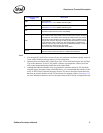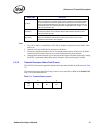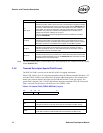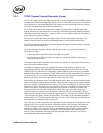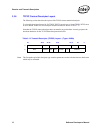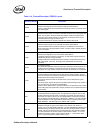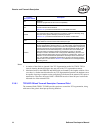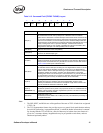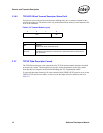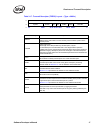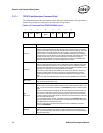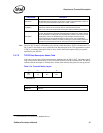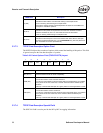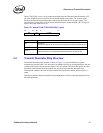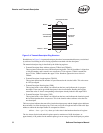
Receive and Transmit Description
Software Developer’s Manual 45
Table 3-15. Command Field (TDESC.TUCMD) Layout
Note:
1. The IDE, DEXT, and RS bits are valid regardless of the state of TSE. All other bits are ignored
if TSE = 0b.
2. The TCP Segmentation feature also provides access to a generic block send function and may
be useful for performing “segmentation offload” in which the header information is constant.
By clearing both the TCP and IP bits, a block of data may be broken down into frames of a
given size, a constant, arbitrary length header may be pre-pended to each frame, and two
checksums optionally added.
7 6 5 4 3 2 1 0
IDE RSV DEXT RSV RS TSE IP TCP
TDESC.TUCMD Description
IDE (bit 7)
Interrupt Delay Enable
IDE activates the transmit interrupt delay timer. Hardware loads a countdown
register when it writes back a transmit descriptor that has the RS bit and the IDE bit
set. The value loaded comes from the IDV field of the Interrupt Delay (TIDV) register.
When the count reaches 0, a transmit interrupt occurs. Hardware always loads the
transmit interrupt counter whenever it processes a descriptor with IDE set even if it is
already counting down due to a previous descriptor. If hardware encounters a
descriptor that has RS set, but not IDE, it generates an interrupt immediately after
writing back the descriptor. The interrupt delay timer is cleared.
RSV (Bit 6) Reserved. Set to 0b for future compatibility.
DEXT(Bit 5)
Descriptor Extension
Must be 1b for this descriptor type.
RSV (Bit 4) Reserved. Set to 0b for future compatibility.
RS (Bit 3)
Report Status
RS tells the hardware to report the status information for this descriptor. Because this
descriptor does not transmit data, only the DD bit in the status word is valid. Refer to
Section 3.3.6.2 for the layout of the status field.
TSE (Bit 2)
TCP Segmentation Enable
TSE indicates that this descriptor is setting the TCP segmentation context. If this bit
is not set, the checksum offloading context for normal (non-”TCP Segmentation”)
packets is written. When a descriptor of this type is processed the Ethernet controller
immediately updates the context in question (TCP Segmentation or checksum
offloading) with values from the descriptor. This means that if any normal packets or
TCP Segmentation packets are in progress (a descriptor with EOP set has not been
received for the given context), the results are likely to be undesirable.
IP (Bit 1)
Packet Type (IPv4 = 1b, IPv6 = 0b)
Identifies what type of IP packet is used in the segmentation process. This is
necessary for hardware to know where the IP Payload Length field is located. This
does not override the checksum insertion bit, IXSM.
IP (Bit 1)
82544GC/EI only
Packet Type (IP = 1b)
Identifies the packet as an IP packet. The purpose of this bit is to enable/disable the
updating of the IP header during the segmentation process. This does not override
the checksum insertion bit, IXSM.
TCP (bit 0)
Packet Type (TCP = 1b)
Identifies the packet as either TCP or UDP (non-TCP). This affects the processing of
the header information.



